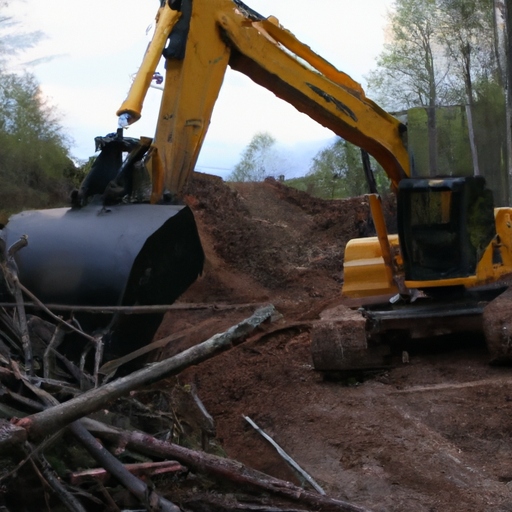What Is A Common Way To Clear Land? So, you’ve found yourself with a piece of land that needs clearing, and now you’re wondering about the most common way to tackle this task. Well, look no further! In this article, we’re going to explore a tried and true method that is widely employed to clear land effectively. From overgrown vegetation to unwanted debris, prepare to discover a solution that will help you transform your patch of land into a clean slate, ready for whatever you have in mind.

Introduction
When it comes to clearing land, there are several methods and techniques available, each with its own advantages and disadvantages. The choice of land clearing method depends on factors such as the size of the area, the type of vegetation, and the desired end result. In this article, we will explore various methods of land clearing, including manual clearing, mechanized clearing, chemical clearing, controlled burning, clearcutting, mulching, explosives, and root plowing. We will also discuss the regulations and environmental considerations associated with land clearing practices.
1. Manual Clearing
1.1 Clearing with Hand Tools
Manual clearing involves the use of hand tools to remove vegetation and debris. This method is often suitable for small areas or when preserving the existing landscape is a priority. Hand tools like axes, chainsaws, and machetes are commonly used to cut down trees and clear away brush. While manual clearing can be time-consuming and physically demanding, it allows for greater precision and control over the clearing process.
1.2 Slash and Burn
Slash and burn is a traditional method of land clearing that involves cutting down vegetation and then burning it. This technique is commonly used in agricultural practices, particularly in tropical regions. While slash and burn can quickly clear large areas, it has significant environmental implications. The burning of vegetation releases carbon dioxide and other greenhouse gases into the atmosphere, contributing to air pollution and climate change. It can also lead to soil degradation and loss of biodiversity.
1.3 Grazing
Grazing is another method of land clearing commonly used in agricultural settings. In this approach, livestock such as cattle or sheep are allowed to graze on the vegetation, effectively clearing the land. Grazing can be an efficient way to maintain vegetation and control overgrowth. However, it requires careful management to prevent overgrazing and the destruction of native plant species. Additionally, grazing may not be suitable for all types of land or vegetation.
2. Mechanized Clearing
2.1 Bulldozers
Bulldozers are powerful machines widely used in land clearing operations. Equipped with large blades, they can push through vegetation, trees, and debris, effectively clearing the land. Bulldozers are particularly effective in clearing large areas quickly. However, their use can result in extensive soil compaction and damage to the root systems of remaining trees. Proper planning and skilled operators are necessary to minimize these environmental impacts.
2.2 Excavators
Excavators are versatile machines that can be used for various land clearing tasks. With their hydraulic attachments, they can effectively remove trees, stumps, and rocks from the land. Excavators are suitable for both small-scale and large-scale clearing projects. However, their use requires skilled operators as they can cause unintended damage if not operated correctly. Like bulldozers, excavators can also lead to soil compaction and disrupt the natural environment.
2.3 Chainsaws
Chainsaws are handheld mechanical tools commonly used in land clearing. They are particularly useful for cutting down trees and removing unwanted vegetation. Chainsaws come in different sizes and power capacities, making them suitable for both small and large clearing tasks. However, chainsaw operations require proper safety precautions and skilled operators. The noise and vibrations produced by chainsaws can also have negative impacts on the surrounding environment and wildlife.
3. Chemical Clearing
3.1 Herbicides
Chemical clearing involves the use of herbicides to kill and remove vegetation. Herbicides work by inhibiting the growth and development of plants. This method is often used to clear large areas quickly and efficiently. However, the use of herbicides raises concerns regarding their potential impacts on human health and the environment. It is crucial to follow strict regulations and guidelines for the application and disposal of herbicides to minimize these risks.
3.2 Biochemicals
Biochemicals are an alternative to traditional chemical herbicides. These substances are derived from naturally occurring compounds and are considered to be more environmentally friendly. Biochemicals target specific plant species, reducing the risk of harming non-target organisms. However, their effectiveness can vary depending on the vegetation and environmental conditions. Proper research and testing are essential when using biochemicals for land clearing purposes.

4. Controlled Burning
4.1 Backfire
Backfire is a controlled burning technique used in land clearing. It involves intentionally setting a fire along the edge of an area to create a burned strip, which serves as a barrier to stop or redirect the main fire. Backfire is commonly used in wildfire control and land management practices. While it can effectively clear vegetation, backfires should be carefully planned and executed to prevent the fire from spreading uncontrollably and causing unintended damage.
4.2 Headfire
Headfire is another controlled burning technique used in land clearing. Unlike backfire, headfire involves setting a fire at the front of an area, allowing it to burn through the vegetation in a controlled manner. This technique is often used in prairie restoration and ecosystem management. Proper planning, monitoring, and firefighting resources are crucial when implementing headfires to ensure the fire remains under control and minimize potential risks.
4.3 Strip Merchant
Strip merchant is a controlled burning technique mainly used in forestry operations. It involves creating narrow strips of burned vegetation to facilitate the removal of timber. This method allows for the efficient extraction of valuable timber while minimizing the risk of uncontrolled fire and damage to the surrounding environment. However, strip merchant requires careful planning and monitoring to ensure the fire does not spread beyond the designated strips.
5. Clearcutting
5.1 What is Clearcutting?
Clearcutting is a method of land clearing where all trees in an area are cut down, leaving a large open space. It is often used in forestry operations to harvest timber on a large scale. Clearcutting can be an efficient way to maximize timber production and create space for regeneration. However, it has significant ecological impacts, including the loss of habitat, disruption of ecosystems, and soil erosion. Proper planning and management practices are crucial to mitigate the negative effects of clearcutting.
5.2 Pros and Cons of Clearcutting
Clearcutting has both advantages and disadvantages. On the positive side, clearcutting allows for efficient timber harvesting, stimulates forest regeneration, and can create open spaces for new plant and animal species to thrive. It also simplifies forest management and reduces the risk of forest fires. However, the negative impacts of clearcutting include habitat destruction, loss of biodiversity, soil erosion, and changes in microclimate. The long-term ecological consequences of clearcutting need to be carefully considered in sustainable forest management.

6. Mulching
6.1 Types of Mulch
Mulching is a land clearing method that involves spreading organic or inorganic materials over the soil surface. Organic mulch, such as wood chips or straw, helps improve soil fertility and moisture retention while suppressing the growth of weeds. Inorganic mulch, such as gravel or plastic, provides a barrier against weed growth but does not contribute to soil health. The choice of mulch depends on the specific land clearing goals, site conditions, and availability of materials.
6.2 Mulching Techniques
There are various mulching techniques that can be applied depending on the land clearing objectives. Sheet mulching involves spreading a layer of organic materials, such as cardboard or newspaper, followed by a layer of mulch. This technique helps smother existing vegetation and prepare the soil for future planting. Chipped mulching involves using wood chips to cover the soil surface, providing a protective layer and enhancing soil fertility. Mulching can also be supplemented with herbicides to further suppress weed growth, though caution should be exercised to prevent environmental harm.
6.3 Benefits of Mulching
Mulching offers several benefits beyond land clearing. It helps conserve moisture in the soil, reducing the need for irrigation. It also acts as an insulating layer, protecting the soil from extreme temperatures and reducing erosion. Moreover, mulch promotes soil fertility by adding organic matter and nutrients over time as it decomposes. Additionally, mulching reduces weed competition, which is particularly advantageous when preparing land for cultivation or landscaping. Overall, mulching is a sustainable and environmentally friendly land clearing method that supports healthy soil and plant growth.
7. Explosives
7.1 Traditional Dynamite
Explosives, such as traditional dynamite, can be used for land clearing purposes, particularly in areas with large rocks or boulders that are difficult to remove mechanically. The controlled detonation of explosives can effectively break up rocks or dislodge stubborn vegetation. However, the use of explosives requires specialized knowledge and proper safety measures to minimize risks to human safety and the surrounding environment. It is crucial to comply with local regulations and guidelines when using explosives for land clearing.
7.2 Controlled Blasting
Controlled blasting is a more advanced technique that involves precise calculations and controlled detonations to remove specific structures or vegetation. It is commonly used in construction projects and road building. Controlled blasting allows for greater precision and minimal collateral damage, making it a preferred method in certain situations. However, as with any explosive technique, utmost caution is necessary to ensure the safety of nearby structures, wildlife, and people.

8. Root Plowing
8.1 What is Root Plowing?
Root plowing is a land clearing method that involves using heavy machinery to uproot vegetation, primarily trees and shrubs. A root plow attachment is equipped to bulldozers or tractors, allowing for the removal of plant roots along with the above-ground vegetation. The plowing action breaks up the soil and clears the land, creating a blank canvas for subsequent land use. Root plowing is often used in large-scale land clearing projects, such as preparing land for agricultural cultivation or infrastructure development.
8.2 Effectiveness and Impact
Root plowing is an effective method for clearing land quickly and efficiently, especially when dealing with deep-rooted vegetation. By removing the roots, it eliminates the potential for regrowth and minimizes the need for additional clearing efforts. However, the use of heavy machinery can cause soil compaction and disturbance, affecting the soil structure and nutrient composition. It is essential to carefully evaluate the soil conditions and implement proper soil conservation practices to mitigate the negative impacts of root plowing.
10. Regulations and Environmental Considerations
10.1 Environmental Impact Assessments
Before undertaking any land clearing project, it is essential to conduct thorough environmental impact assessments (EIAs). EIAs evaluate the potential impacts of land clearing activities on the surrounding environment, including ecosystems, water sources, and wildlife habitats. They help identify risks, develop mitigation measures, and ensure compliance with local regulations and environmental standards. Proper planning, monitoring, and mitigation are crucial to minimize the ecological footprint of land clearing and promote sustainable land management practices.
10.2 Sustainable Land Clearing Practices
To mitigate the adverse effects of land clearing, it is important to adopt sustainable land clearing practices. This includes using methods that minimize soil disturbance, preserving as much native vegetation as possible, and implementing erosion control measures. Additionally, reforestation and habitat restoration programs should be prioritized to offset the loss of vegetation and biodiversity. Engaging with local communities, indigenous peoples, and environmental organizations can also contribute to the development of sustainable land clearing guidelines and practices.
In conclusion, land clearing is a necessary process in various contexts, from agriculture to forestry and infrastructure development. However, the choice of land clearing method and its appropriate implementation are crucial to minimize the environmental impacts and ensure long-term sustainability. By understanding the different techniques and considering the regulations and environmental considerations, land clearing can be carried out in a responsible and environmentally friendly manner.


